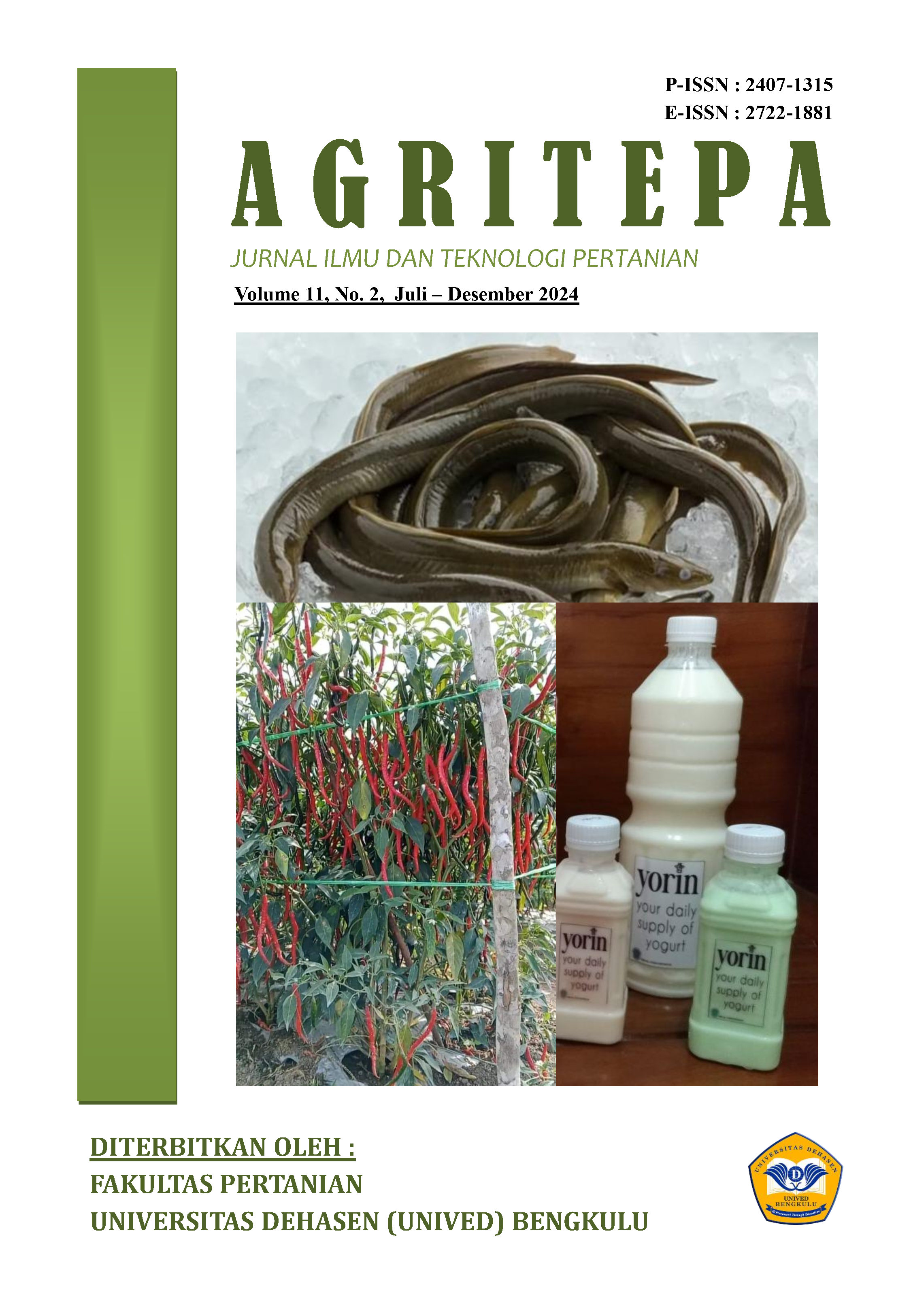Comparative Study Of Solar Drying And Freeze Drying Methods In Amino Acid Content Of Crude Ficin Enzyme From Ficus Aurata (Miq.)
Abstract
Purpose: This work aimed to analyze the profiles of amino acids in the ficin enzyme isolated from Ficus aurata (Miq.), and to determine the efficiency of these amino acid concentrations under two types of drying – solar drying and freeze drying. Methodology: The enzyme ficin was obtained from fig tree, and the presence of amino acids was determined by UPL chromatography. The applied methods of drying were solar and freeze. However, the primary objectives were aimed at investigating the influence of these treatments on the level of amino acids present in all the samples. Results: The findings indicated that freeze drying techniques retained more amino acids in figs than was observed in the case of solar drying. In particular, the amount of L-glutamic acid in freeze drying was 2.39 mg/g, while that of solar drying was 1.43 mg/g. Similar results were observed in L-lysine and L-aspartic acid, which were relatively higher in freeze drying than solar drying, with concentrations of 2.43 mg/g and 2.55 mg/g, respectively, as opposed to 0.99 mg/g and 1.76 mg/g in solar drying. Besides, freeze drying showed better L-serine, L-phenylalanine, and L-histidine preservation. Findings: It was observed that freeze drying gave the best opportunity to reduce the loss of amino acid of the ficin enzyme. The drying method, in particular, resulted in a concentration of some important amino acids like L-glutamic acid, L-lysine, L-aspartic acid, L-serine and L-phenylalanine, and L-histidine as compared to solar drying. Novelty: This study focused on different types of solar energy and freeze energy economic systems in enzymatic activities in the ficin enzyme extracted from Ficus aurata (Miq.). The novel contribution of this research lies in its objective, which is to show how the drying methods used affected the retention of the most influential and critical amino acids in the enzymatic processes. Originality: The novel aspect of the study was the attachment of ultra vortices to different drying techniques, such as solar drying and freeze drying in select ficin enzymes from Ficus aurata. It opens up a new perspective toward the development of drying parameters for the enhancement of important enzymatic characters from this particular variety. Conclusion: This research considers the changes in amino acid content during the drying of ficin enzyme from Ficus aurata through different drying methods. It is shown that freeze drying enhances the retention of critical amino acids and is thus one of the most efficient methods for the enzymatic processing of this plant species. Type of Paper: Empirical research paper.
Downloads
References
Ajeigbe, O. F. (2023). Enriched Biscuits of Ficus Capensis Modulates Neurobehavioral Performance and Antioxidant Status of L-Name Induced Hypertensive Rats With Anxiety-Like Behaviour. https://doi.org/10.21203/rs.3.rs-3504759/v1
Amani, S., Mohebodini, M., Khademvatan, S., & Jafari, M. (2020). Agrobacterium Rhizogenes Mediated Transformation of Ficus Carica L. For the Efficient Production of Secondary Metabolites. Journal of the Science of Food and Agriculture. https://doi.org/10.1002/jsfa.10243
Ariza, O. (2024). Innovative Solar Dryer for Sustainable Aloe Vera Gel Preservation in Colombia. Sustainability. https://doi.org/10.3390/su16083392
Baidamshina, D. R. (2023). The Effect of Ficin Immobilized on Carboxymethyl Chitosan on Biofilms of Oral Pathogens. International Journal of Molecular Sciences. https://doi.org/10.3390/ijms242216090
Ajeigbe, O. F. (2023). Enriched Biscuits of Ficus Capensis Modulates Neurobehavioral Performance and Antioxidant Status of L-Name Induced Hypertensive Rats With Anxiety-Like Behaviour. https://doi.org/10.21203/rs.3.rs-3504759/v1
Amani, S., Mohebodini, M., Khademvatan, S., & Jafari, M. (2020). Agrobacterium Rhizogenes Mediated Transformation of Ficus Carica L. For the Efficient Production of Secondary Metabolites. Journal of the Science of Food and Agriculture. https://doi.org/10.1002/jsfa.10243
Ariza, O. (2024). Innovative Solar Dryer for Sustainable Aloe Vera Gel Preservation in Colombia. Sustainability. https://doi.org/10.3390/su16083392
Baidamshina, D. R. (2023). The Effect of Ficin Immobilized on Carboxymethyl Chitosan on Biofilms of Oral Pathogens. International Journal of Molecular Sciences. https://doi.org/10.3390/ijms242216090
Faccia, M., Apruzzese, D., & Passaro, P. (2019). Making Cheese With Caprifig Sap in Apulia, Italy: Possible Rebirth of an Ancient Tradition. J. Ethn. Food. https://doi.org/10.1186/s42779-019-0007-5
Farooq, A., Jiang, S., Farooq, A., Naeem, M. A., Ahmad, A., & Liu, L. (2019). Structure and Properties of High Quality Natural Cellulose Nano Fibrils From a Novel Material Ficus Natalensis Barkcloth. Journal of Industrial Textiles. https://doi.org/10.1177/1528083719887533
Gagaoua, M., Boucherba, N., Bouanane-Darenfed, A., Ziane, F., Nait-Rabah, S., Hafid, K., & Boudechicha, H. R. (2014). Three-phase partitioning as an efficient method for the purification and recovery of ficin from Mediterranean fig (Ficus carica L.) latex. Separation and Purification Technology, 132. https://doi.org/10.1016/j.seppur.2014.05.050
Ghribi, F. (2023). Nutritional Comparison of Fish Species From the Bizerte Lagoon (Mediterranean Coasts). Journal of Biomedical Research & Environmental Sciences. https://doi.org/10.37871/jbres1757
Hermosilla, J., Pastene, E., & Acevedo, F. (2021). Electrospun Fibers Loaded With Natural Bioactive Compounds as a Biomedical System for Skin Burn Treatment. A Review. Pharmaceutics. https://doi.org/10.3390/pharmaceutics13122054
Hira, S., Gülfraz, M., Naqvi, S., Qureshi, R. U., & Gül, H. (2021). Protective Effect of Leaf Extract of Ficus Carica L. Against Carbon Tetrachloride-Induced Hepatic Toxicity in Mice and HepG2 Cell Line. Tropical Journal of Pharmaceutical Research. https://doi.org/10.4314/tjpr.v20i1.17
Iwaniak, A., Hrynkiewicz, M., Minkiewicz, P., Bucholska, J., & Darewicz, M. (2020). Soybean (Glycine Max) Protein Hydrolysates as Sources of Peptide Bitter-Tasting Indicators: An Analysis Based on Hybrid and Fragmentomic Approaches. Applied Sciences. https://doi.org/10.3390/app10072514
Karami, Z., Akbari‐adergani, B., & Duangmal, K. (2022). Recent Development on Recovering Bioactive Peptides and Phenolic Compounds From Under‐utilised By‐products During Production of Certain Edible Oil Plants: Current Situation and Future Perspectives. International Journal of Food Science & Technology. https://doi.org/10.1111/ijfs.15838
Kumar, P., & Yao, D. (2022). Design Process of a Vacuum Freeze Dryer: Simultaneous Endpoint Determination Using Measurement of Both Temperature and Relative Humidity. Journal of Food Process Engineering. https://doi.org/10.1111/jfpe.14003
Liburdi, K., Boselli, C., Giangolini, G., Amatiste, S., & Esti, M. (2019). An Evaluation of the Clotting Properties of Three Plant Rennets in the Milks of Different Animal Species. Foods. https://doi.org/10.3390/foods8120600
Marinescu, S. A. (2019). Study on the Concentrate of Proteolytic Enzymes Enriched in Bromelain and Its Effects on Intermediate and Extensive Burns. Farmacia. https://doi.org/10.31925/farmacia.2019.3.22
Mule, & Naikwade. (2022). Effect of Fruit and Cork Extract of Ficus Lacor Buch Ham on Α/Β -Glucosidase, Α -Amylase, Lipase, Glucose Absorption and Uptake. International Journal of Life Science and Pharma Research. https://doi.org/10.22376/ijpbs/lpr.2021.11.6.p67-76
Nova, I. C., de Almeida, W. A., Procópio, T. F., Maia Godoy, R. S., Miranda, F. R., Barbosa, R. C., … Pontual, E. V. (2022). Extract From Opuntia Ficus‐indica Cladode Delays the Aedes Aegypti Larval Development by Inducing an Axenic Midgut Environment. Archives of Insect Biochemistry and Physiology. https://doi.org/10.1002/arch.21872
Osiako, F. H., Samuel, B. B., & Oluyemi, W. M. (2023). Effects of Selected Terminalia and Ficus Species in the Inhibition of α-Amylase and α-Glucosidase Enzymes. Tropical Journal of Natural Product Research, 7(8), 3775–3780. https://doi.org/10.26538/tjnpr/v7i8.31
Ozcan, F. (2022). Determination of Digestive Enzyme Activity in Gilt-Head Sea Bream (Sparus Aurata ) Feeding With Commercial Feed. Black Sea Journal of Agriculture. https://doi.org/10.47115/bsagriculture.983542
Postiglione, G., Accorsi, P. A., Ganswindt, A., & Crossey, B. (2022). A Field-Friendly Alternative to Freeze-Drying Faeces for Glucocorticoid Metabolite Analyses of African Wild Dogs (Lycaon Pictus). Methodsx. https://doi.org/10.1016/j.mex.2022.101623
Quirós-Pozo, R., Moyano, F. J., Bainour, K., Ramírez-Bolaños, S., Ventura-Castellano, A., Roo, J., & Robaina, L. (2023). Evaluation of the Effects of Two Different Feeding Frequencies on the Digestive Biochemistry of Two Mullet Species (Chelon Labrosus and Liza Aurata). Animals. https://doi.org/10.3390/ani13020287
Shafiee, S., Goli, M., Khoshkhoo, Z., & Hosseini, S. E. (2021). Optimization of Hydrolysis Conditions (Temperature, Time, and Concentration of Alkalase) of Rainbow Trout Viscera Using the Response Surface Methodology. Journal of Food Processing and Preservation. https://doi.org/10.1111/jfpp.15456
Shearer, A. E., & Kniel, K. E. (2021). Effect of Plant-Derived Proteases on Infectivity of Tulane Virus, Murine Norovirus, and Hepatitis a Virus. Journal of Food Protection. https://doi.org/10.4315/jfp-20-296
Swargiary, A., Verma, A. K., & Daimari, M. (2020). GC-MS Analysis of Major Compounds and Antihyperglycemic and Cytotoxicity Properties of Ficus Racemosa L. Fruit Extract: An in-Vitro and in-Silico Study. https://doi.org/10.21203/rs.3.rs-77521/v1
Trevisol, T. C., Henriques, R. O., Antunes Souza, A. J., & Fúrigo, A. (2021). An Overview of the Use of Proteolytic Enzymes as Exfoliating Agents. Journal of Cosmetic Dermatology. https://doi.org/10.1111/jocd.14673
Uba, G., Manogaran, M., Gunasekaran, B., Effendi Halmi, M. I., & Shukor, M. Y. (2020). Improvement of Ficin-Based Inhibitive Enzyme Assay for Toxic Metals Using Response Surface Methodology and Its Application for Near Real-Time Monitoring of Mercury in Marine Waters. International Journal of Environmental Research and Public Health. https://doi.org/10.3390/ijerph17228585
Xia, X., Peng, J., Yang, L., Zhao, X., Duan, A., & Wang, D. (2022). Comparative Analysis of the Complete Chloroplast Genomes of Eight Ficus Species and Insights Into the Phylogenetic Relationships of Ficus. Life. https://doi.org/10.3390/life12060848
Zheng, Z., Wang, M., Li, J., Li, J., & Liu, Y. (2020). Comparative Assessment of Physicochemical and Antioxidative Properties of Mung Bean Protein Hydrolysates. RSC Advances. https://doi.org/10.1039/c9ra06468k
Сорокин, А. В., Goncharova, S. S., Lavlinskaya, M. S., Holyavka, M. G., Faizullin, D. A., Zuev, Y. F., … Artyukhov, V. G. (2023). Complexation of Bromelain, Ficin, and Papain With the Graft Copolymer of Carboxymethyl Cellulose Sodium Salt and N-Vinylimidazole Enhances Enzyme Proteolytic Activity. International Journal of Molecular Sciences, 24(14), 11246. https://doi.org/10.3390/ijms241411246
Faccia, M., Apruzzese, D., & Passaro, P. (2019). Making Cheese With Caprifig Sap in Apulia, Italy: Possible Rebirth of an Ancient Tradition. J. Ethn. Food. https://doi.org/10.1186/s42779-019-0007-5
Farooq, A., Jiang, S., Farooq, A., Naeem, M. A., Ahmad, A., & Liu, L. (2019). Structure and Properties of High Quality Natural Cellulose Nano Fibrils From a Novel Material Ficus Natalensis Barkcloth. Journal of Industrial Textiles. https://doi.org/10.1177/1528083719887533
Gagaoua, M., Boucherba, N., Bouanane-Darenfed, A., Ziane, F., Nait-Rabah, S., Hafid, K., & Boudechicha, H. R. (2014). Three-phase partitioning as an efficient method for the purification and recovery of ficin from Mediterranean fig (Ficus carica L.) latex. Separation and Purification Technology, 132. https://doi.org/10.1016/j.seppur.2014.05.050
Ghribi, F. (2023). Nutritional Comparison of Fish Species From the Bizerte Lagoon (Mediterranean Coasts). Journal of Biomedical Research & Environmental Sciences. https://doi.org/10.37871/jbres1757
Hermosilla, J., Pastene, E., & Acevedo, F. (2021). Electrospun Fibers Loaded With Natural Bioactive Compounds as a Biomedical System for Skin Burn Treatment. A Review. Pharmaceutics. https://doi.org/10.3390/pharmaceutics13122054
Hira, S., Gülfraz, M., Naqvi, S., Qureshi, R. U., & Gül, H. (2021). Protective Effect of Leaf Extract of Ficus Carica L. Against Carbon Tetrachloride-Induced Hepatic Toxicity in Mice and HepG2 Cell Line. Tropical Journal of Pharmaceutical Research. https://doi.org/10.4314/tjpr.v20i1.17
Iwaniak, A., Hrynkiewicz, M., Minkiewicz, P., Bucholska, J., & Darewicz, M. (2020). Soybean (Glycine Max) Protein Hydrolysates as Sources of Peptide Bitter-Tasting Indicators: An Analysis Based on Hybrid and Fragmentomic Approaches. Applied Sciences. https://doi.org/10.3390/app10072514
Karami, Z., Akbari‐adergani, B., & Duangmal, K. (2022). Recent Development on Recovering Bioactive Peptides and Phenolic Compounds From Under‐utilised By‐products During Production of Certain Edible Oil Plants: Current Situation and Future Perspectives. International Journal of Food Science & Technology. https://doi.org/10.1111/ijfs.15838
Kumar, P., & Yao, D. (2022). Design Process of a Vacuum Freeze Dryer: Simultaneous Endpoint Determination Using Measurement of Both Temperature and Relative Humidity. Journal of Food Process Engineering. https://doi.org/10.1111/jfpe.14003
Liburdi, K., Boselli, C., Giangolini, G., Amatiste, S., & Esti, M. (2019). An Evaluation of the Clotting Properties of Three Plant Rennets in the Milks of Different Animal Species. Foods. https://doi.org/10.3390/foods8120600
Marinescu, S. A. (2019). Study on the Concentrate of Proteolytic Enzymes Enriched in Bromelain and Its Effects on Intermediate and Extensive Burns. Farmacia. https://doi.org/10.31925/farmacia.2019.3.22
Mule, & Naikwade. (2022). Effect of Fruit and Cork Extract of Ficus Lacor Buch Ham on Α/Β -Glucosidase, Α -Amylase, Lipase, Glucose Absorption and Uptake. International Journal of Life Science and Pharma Research. https://doi.org/10.22376/ijpbs/lpr.2021.11.6.p67-76
Nova, I. C., de Almeida, W. A., Procópio, T. F., Maia Godoy, R. S., Miranda, F. R., Barbosa, R. C., … Pontual, E. V. (2022). Extract From Opuntia Ficus‐indica Cladode Delays the Aedes Aegypti Larval Development by Inducing an Axenic Midgut Environment. Archives of Insect Biochemistry and Physiology. https://doi.org/10.1002/arch.21872
Osiako, F. H., Samuel, B. B., & Oluyemi, W. M. (2023). Effects of Selected Terminalia and Ficus Species in the Inhibition of α-Amylase and α-Glucosidase Enzymes. Tropical Journal of Natural Product Research, 7(8), 3775–3780. https://doi.org/10.26538/tjnpr/v7i8.31
Ozcan, F. (2022). Determination of Digestive Enzyme Activity in Gilt-Head Sea Bream (Sparus Aurata ) Feeding With Commercial Feed. Black Sea Journal of Agriculture. https://doi.org/10.47115/bsagriculture.983542
Postiglione, G., Accorsi, P. A., Ganswindt, A., & Crossey, B. (2022). A Field-Friendly Alternative to Freeze-Drying Faeces for Glucocorticoid Metabolite Analyses of African Wild Dogs (Lycaon Pictus). Methodsx. https://doi.org/10.1016/j.mex.2022.101623
Quirós-Pozo, R., Moyano, F. J., Bainour, K., Ramírez-Bolaños, S., Ventura-Castellano, A., Roo, J., & Robaina, L. (2023). Evaluation of the Effects of Two Different Feeding Frequencies on the Digestive Biochemistry of Two Mullet Species (Chelon Labrosus and Liza Aurata). Animals. https://doi.org/10.3390/ani13020287
Shafiee, S., Goli, M., Khoshkhoo, Z., & Hosseini, S. E. (2021). Optimization of Hydrolysis Conditions (Temperature, Time, and Concentration of Alkalase) of Rainbow Trout Viscera Using the Response Surface Methodology. Journal of Food Processing and Preservation. https://doi.org/10.1111/jfpp.15456
Shearer, A. E., & Kniel, K. E. (2021). Effect of Plant-Derived Proteases on Infectivity of Tulane Virus, Murine Norovirus, and Hepatitis a Virus. Journal of Food Protection. https://doi.org/10.4315/jfp-20-296
Swargiary, A., Verma, A. K., & Daimari, M. (2020). GC-MS Analysis of Major Compounds and Antihyperglycemic and Cytotoxicity Properties of Ficus Racemosa L. Fruit Extract: An in-Vitro and in-Silico Study. https://doi.org/10.21203/rs.3.rs-77521/v1
Trevisol, T. C., Henriques, R. O., Antunes Souza, A. J., & Fúrigo, A. (2021). An Overview of the Use of Proteolytic Enzymes as Exfoliating Agents. Journal of Cosmetic Dermatology. https://doi.org/10.1111/jocd.14673
Uba, G., Manogaran, M., Gunasekaran, B., Effendi Halmi, M. I., & Shukor, M. Y. (2020). Improvement of Ficin-Based Inhibitive Enzyme Assay for Toxic Metals Using Response Surface Methodology and Its Application for Near Real-Time Monitoring of Mercury in Marine Waters. International Journal of Environmental Research and Public Health. https://doi.org/10.3390/ijerph17228585
Xia, X., Peng, J., Yang, L., Zhao, X., Duan, A., & Wang, D. (2022). Comparative Analysis of the Complete Chloroplast Genomes of Eight Ficus Species and Insights Into the Phylogenetic Relationships of Ficus. Life. https://doi.org/10.3390/life12060848
Zheng, Z., Wang, M., Li, J., Li, J., & Liu, Y. (2020). Comparative Assessment of Physicochemical and Antioxidative Properties of Mung Bean Protein Hydrolysates. RSC Advances. https://doi.org/10.1039/c9ra06468k
Copyright (c) 2024 Ismed Ismed, Rina Yenrina, Hasbullah Hasbullah, Daimon Syukri, Yusniwati Yusniwati (Author)

This work is licensed under a Creative Commons Attribution-ShareAlike 4.0 International License.
Author retains the copyright and grants the journal the right of first publication of the work simultaneously licensed under the Creative Commons Attribution-ShareAlike 4.0 License that allows others to share the work with an acknowledgement of the work's authorship and initial publication in this journal













